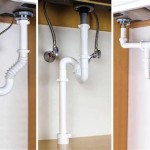What Size Is A Standard Bathroom Sink Drainer?
Determining the correct size of a bathroom sink drainer is essential for ensuring proper water drainage and preventing leaks. The drainer, also often called a drain assembly, connects to the sink basin and channels wastewater into the plumbing system. While there may be some variation, a standard size prevails in most residential bathroom installations. Deviating from this standard can lead to compatibility issues with existing plumbing and difficulty in finding replacement parts. This article delineates the standard size, its components, factors influencing size choices, and considerations for replacement and installation.
The primary function of a bathroom sink drainer is to provide a watertight channel for water to exit the sink. It typically consists of several components, including a drain flange that sits inside the sink basin, a drain pipe that extends downward, a tailpiece connecting the drain pipe to the P-trap, and associated washers and nuts to create a secure seal. Understanding these components is crucial for accurately identifying and replacing a drainer.
A properly functioning drainer prevents water from pooling in the sink, which can lead to staining, corrosion, and unsanitary conditions. Furthermore, a secure and leak-free drainer prevents water damage to the cabinet below the sink and the surrounding floor. Selecting the correct size and ensuring proper installation are therefore vital to maintaining a functional and aesthetically pleasing bathroom.
The Standard Drainer Size: 1-1/4 Inch
The most common size for a bathroom sink drainer is 1-1/4 inches (3.175 cm) in diameter. This measurement refers to the inner diameter of the drain pipe. This standard size is widely adopted in residential plumbing because it provides an optimal balance between water flow capacity and pipe size, aligning well with typical water usage in bathrooms. It is also a practical size for connecting to standard P-traps and drain pipes.
The 1-1/4 inch standard is largely consistent across different sink types, including pedestal sinks, vanity sinks, and wall-mounted sinks. While variations exist, particularly in older homes or specialized installations, the 1-1/4 inch drainer is the generally accepted norm for modern bathroom sink installations. This standardization simplifies the plumbing process and makes it easier to find compatible components.
It's important to note that while the inner diameter is the critical measurement, the outer diameter of the drain pipe will be slightly larger due to the pipe wall thickness. However, when seeking a replacement drainer, the 1-1/4 inch inner diameter is the specification to focus on. Mismatches in size can lead to difficulties in connecting to the existing plumbing.
The universality of the 1-1/4 inch drainer size ensures that homeowners and plumbers can readily find compatible replacement parts, such as drain stoppers, flanges, and tailpieces, at most hardware stores. This ease of access contributes to the overall convenience and cost-effectiveness of maintaining a 1-1/4 inch drain system.
Factors Influencing Drainer Size Choices
While 1-1/4 inches is the standard, certain factors can influence the choice of drainer size. These factors typically involve specialized applications or unique plumbing configurations. Some considerations might necessitate deviating from the standard size. These are generally related to older plumbing systems or specific design features.
One such factor is the age of the plumbing system. Older homes, particularly those built before modern plumbing codes were established, might have different drain pipe sizes. In these cases, adapting to the existing plumbing infrastructure might require using a drainer of a different size or using adapter fittings to connect a standard 1-1/4 inch drainer. Before making any modifications, thoroughly inspect the current system.
Another factor is the type of sink being installed. While most standard bathroom sinks use a 1-1/4 inch drainer, some larger or specialized sinks might require a larger drainer to handle a higher volume of water. For example, a double vanity sink or a commercial-grade sink might benefit from a larger drainer, such as 1-1/2 inches, to prevent water from backing up in the basin. In these scenarios, assessing the sink's intended use and water flow rate is essential.
The drain configuration can also influence the drainer size. Sinks with unusual drain placements or complex drain systems might require a different drainer size or specialized fittings to ensure proper water flow and drainage. Consulting with a plumbing professional can help determine the appropriate solution for these unique situations.
Another, albeit less common, consideration is the material of the drain pipe. While PVC and metal pipes are generally manufactured to standard sizes, variations can occur due to manufacturing tolerances. In rare instances, these variations might necessitate a slightly different drainer size or the use of shims or sealant to ensure a watertight connection.
Drainer Replacement and Installation Considerations
Replacing a bathroom sink drainer is a relatively straightforward task that most homeowners can accomplish with basic plumbing tools and a little guidance. However, proper preparation and attention to detail are crucial for a successful installation and to avoid leaks. Before commencing any work, ensure the water supply to the sink is shut off to prevent flooding.
The first step in replacing a drainer is to carefully remove the old drain assembly. This typically involves loosening the nuts connecting the drain pipe to the tailpiece and the sink basin. Be prepared for some residual water to drain out, and have a bucket or towels ready to catch it. Clean the sink basin and the surrounding area thoroughly to remove any debris or old sealant.
When installing the new drainer, ensure that all the necessary washers and gaskets are properly positioned. These components are essential for creating a watertight seal and preventing leaks. Apply plumber's putty or silicone sealant to the underside of the drain flange before inserting it into the sink basin. This helps to create an additional layer of protection against leaks.
Tighten the nuts connecting the drain pipe to the tailpiece and the sink basin securely, but avoid over-tightening, which can damage the drain pipe or the sink basin. After the installation is complete, turn the water supply back on and check for leaks. If any leaks are detected, tighten the connections further or reapply sealant as needed.
Another important consideration is the type of drain stopper being used. Some drainers come with integrated stoppers, while others require a separate stopper to be installed. Ensure that the chosen stopper is compatible with the drainer and that it functions properly to prevent water from draining out of the sink when desired.
Before replacing a drainer, inspect the existing P-trap. The P-trap's purpose is to trap debris and prevent sewer gases from entering the bathroom. If the P-trap is damaged or corroded, consider replacing it at the same time as the drainer to ensure a complete and functional plumbing system. The P-trap typically connects to the tailpiece of the drainer.
When selecting a new drainer, consider the material. Drainers are commonly made of brass, PVC, or stainless steel. Brass drainers are durable and resistant to corrosion but can be more expensive. PVC drainers are lightweight and inexpensive, but they may not be as durable as brass. Stainless steel drainers offer a good balance of durability and affordability. The chosen material should also be suitable for the type of water being used, as some materials are more resistant to certain types of water.
Finally, when dealing with plumbing projects, it is always prudent to consult with a qualified plumber if you are unsure about any aspect of the installation or if you encounter any unexpected problems. A professional plumber can provide expert advice and ensure that the installation is done correctly and safely.

Standard Bathroom Sink Dimensions With Photos Upgradedhome Com

Standard Vanity Height With Vessel Bathroom Sink Drain Kitchen Countertop Faucets

Pop Up Lift Turn Pull Out Stopper Bathroom Sink Drains

What Is The Standard Size For Drain Hole In A Bathroom Sink Hunker

Pop Up Lift Turn Pull Out Stopper Bathroom Sink Drains

Kitchen Sink Drain Size Pantry Storage Ideas Check More At Http Www Entropiads Com Bathroom Countertop Faucets

Homeowner S Guide To Bathroom Sink Dimensions And Sizes The Family Handyman

The Plumber S Choice 2 1 4 In Bathroom Sink Drain Strainer Basket Replacement For Utility Laundry Rv And Lavatory Sinks Chrome 2ppbs Home Depot

What Size Pipe For Sink Drain Choosing Tips

Cheers Us Bathroom Sink Stopper For All Size Standard Drain Holes Universal Chrome Plated Push Type Bounce Core Anti Clogging Strainer Bathtub Plug With Filter Basket Com
Related Posts







